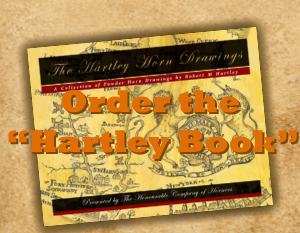Merchandise
January 23, 2022 by Jeff Bibb
Filed under Uncategorized
Merchandise
March 2014 – Message from the Guildmaster
March 3, 2014 by Jeff Bibb
Filed under Message from the Guildmaster
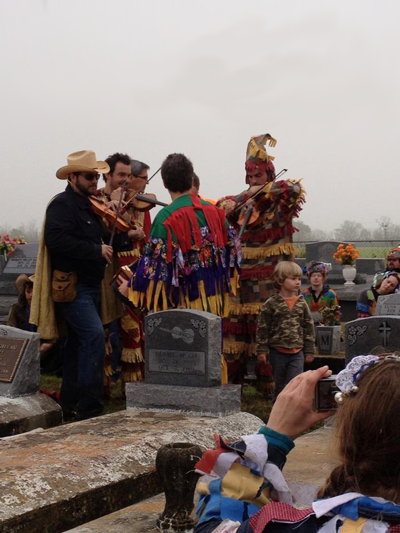
Steve Riley, Joel Savoy, and Wilson Savoy play at the grave of Dennis McGee during Cajun Mardi Gras
Hello:
I am looking forward to seeing many of you this coming weekend in Carlisle. Our annual meeting is always a special time, and this year promises to be a spectacular event. Right now it is snowing in central Virginia with a forecast of four to six inches by this evening. Temperatures are predicted to fall into the upper teens by nightfall, and remain there for a while. March is always unpredictable, and I remember many seasons where our worst storms were very late in the winter. At least the forecast for this weekend looks good, and I wish all of you a safe trip to Carlisle.
In the interim, there is one important holiday to celebrate. Today is Shrove Monday (Lundi Gras) and tomorrow is Fat Tuesday…, Mardi Gras! My friends in southwest Louisiana have already begun their Cajun celebrations, and tomorrow will make their traditional costumed walk, begging for food and party contributions. After much music, merriment, chicken chasing, and trickery, they will culminate the day with a large dinner of gumbo and other Cajun treats, along with a dance. We are also preparing for the day, with plans for costumes, King Cakes, and Cajun fish Po’Boys for dinner. The fiddle is tuned, the accordion is working, and the triangle (tit-fer) is ready, but somehow the snow is putting a slightly different light on things. Laissez les bons temps rouler! But for the moment, let us consider some other things.
Over the past six years I have watched our guild grow and mature in many ways. As for membership, I remember everyone being very excited at the 2008 Williamsburg meeting that we had broken two hundred in our ranks. As of this year, we have eclipsed the four hundred mark, and gaining more members on a regular basis. Let us hope that our efforts will continue to expand our numbers as we have in the past.
Our programs, publications, and funding have experienced similar expansion over the past years. Through the careful management of our funds and expenditures, we are in a better financial position than ever, and I hope this trend will continue. Increased funding has allowed us to expand the scope of our excellent magazine, “The Horn Book”, and to produce other notable publications including The Hartley Book. In 2010 we witnessed a tremendous revamping and expansion of our website with incredible results. Our website is truly something to be proud of, and I hope that you utilize its numerous resources. In late 2013 we began a new groundbreaking project with the HCH Jim Dresslar Digital Museum. All of these projects have been possible through the dedication and efforts of our Publications Committee, and we all owe them a sincere thanks for their efforts.
Education is extremely important for the HCH, and I believe we have made great advances in this area over the past few years. Several members regularly teach horn making classes at the Jacobsburg Historical Museum. Other members teach at Conner Prairie each year for their Art and Arms Making program. On a more local level, we have members who teach workshops at various shows and gatherings each year. Two groups within our organization hold annual workshops in other parts of the country. I believe the West Coast Horn Fair is entering its fourth year , and the smaller Southern Workshop has completed its fourth year as well. Both offer classes and workshops focusing on various aspects of historical horn work for its attendees. At Dixon’s Muzzle Loading Fair, we are represented by members who teach workshops, demonstrate horn making, and serve as judges for the competitions.
All of this growth has resulted from a small group of people who shared a dream for an organization that focused exclusively on historical horn work. Many people have dreams for success in a particular venture. When they surround themselves with like-minded individuals who share the desire, focus and purpose to make it happen, great things can occur. The current state of our guild is the result of this type of enthusiasm, dedication, and just plain hard work. As we celebrate what I believe is our 18th gathering, let’s not forget our purpose and desire to make the HCH even better. To do this, you, our members, have to take the bull by the horns and continue into the future. As I have stated before, this is your organization, and without your involvement and efforts, it could not, and will not, exist.
This is my last monthly message to you as your Guildmaster. Over the past two years, I have delved into a variety of topics, some purely historical, others with a more current focus. While investigating these ideas, I have had a lot of fun exploring their relation to our history and past. I viewed this column as a platform for exploration in many areas, not just as a monthly newsletter for guild business. I hope that my topics have provided you with some entertainment and perhaps something to think about. This month, I thought it was important to focus on the guild, its values, achievements, and future direction. I have great confidence that Dick Toone and our Executive Committee will work to move us into the future, and I encourage your support in whatever way possible.
Thank you for allowing me to serve as your Guildmaster for the past two years, and also for reading and putting up with my monthly ramblings here on the website. It has been a pleasure and an honor to serve you in this capacity. As always, the door is always open for comments, suggestions and other colorful observations.
Sincerely,
Jeff Bibb
Guildmaster
February 2014 – Message from the Guildmaster
February 6, 2014 by Jeff Bibb
Filed under Message from the Guildmaster
Hello:
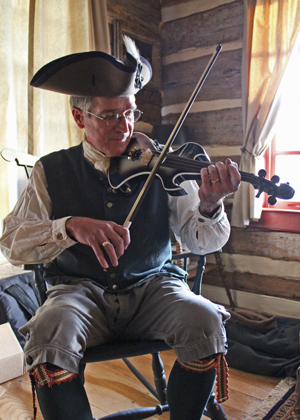
Guildmaster Jeff Bibb.
I hope that the advent of February finds you in good spirits. We are anxiously awaiting the coming of spring and some relief from the cold, stink bugs, and high heating bills .I suspect our forefathers felt much the same way, and looked forward to hearing the birds sing, the greening of the fields, and the promises of another year. Life held no guarantees for our colonial ancestors and the brevity of life for many of them bears this out. We are indeed fortunate to experience life in our time, even with the frustrations that our modern world often provides.
Speaking of high spirits, what more could we all look forward to than the first weekend of March in Carlisle, Pennsylvania? Yes, once again it is time for the annual meeting. I don’t know where the past year went. Seems like only a couple of months ago, I was on my way to Carlisle for the last meeting. This year promises to be a stellar event with more masters workshops including a special bag-making workshop with Frank Willis. Dick Toone has been turning out horns, one after another on the spring pole lathe. Personally, I can’t wait to see what he has learned over the past year’s operations.
On Friday and Saturday, Tom Ames will give two presentations focused on “Symbolism” in horn work. Due to unfortunate circumstances, Tom was unable to attend last year, and we are all looking forward to hearing his thoughts and observations this time around. This topic is a fascinating study, and with Tom’s dedicated research and interest in history, I am sure we are in for a real treat.
The display room will once again be in full swing with a special table for the numerous raffle prizes that folks have generously donated. Thanks to everyone who has helped in this area, and especially to Kris Polizzi, our Fund Raising Chairwoman, who has worked diligently to make our raffles a success. In addition, there will be a special display of original hunting bags and/or bags and horns. At this point, I believe we have around twenty originals lined up to show. This will be a rare opportunity to closely examine numerous links to the past in leatherwork, all under one roof. I should make note that this display will be a strictly “Hands-Off” affair. Because of the fragile nature of 100+ year old leather and fittings, please do not handle any of the bags without explicit permission from the owner.
Another new addition to the displays will be a table hosted by the Southern Chapter. Having just completed our fourth year of gathering and horn-working instruction, we will have a special display featuring all of the horns completed at this year’s meeting, along with various examples of previous years’ work. I hope you will stop by and see what your Southern brothers have been up to.
Of course, Saturday will culminate with the awards presentations and our traditional banquet on Saturday night. Last year was full of surprises for all in attendance, particularly for our past Guildmasters. We have tentative plans for a special speaker at the banquet that I think you will all enjoy. This year, I have been promised that there will be no fireworks and surprises, but with the devious minds of some of our membership, I remain unconvinced. I suppose you will have to attend to see for yourself.
With all of this activity going on, the weekend promises to be a busy occasion. However, I believe the true value of this gathering lies in the assemblage of our members to talk, share, laugh, and celebrate our historical pursuits in grand fashion. Nowhere else can one experience this level of talent and commitment to the furthering of history and horn working. No other organization offers the sharing of information and techniques that are freely passed on to anyone willing to listen and learn. This level of communication and teaching among our membership is unique, and perhaps our most valuable asset. I hope that you will avail yourself of this opportunity to gather with your friends in the coming month. I look forward to seeing all of you there.
The end of this conference will mark new beginnings for the guild in several areas. We are working hard on the first section of the new “HCH Jim Dresslar Digital Museum”. Several hundred images from the original book have already been digitally transferred and are ready for publication. Dick Toone will assume the office of Guildmaster for the coming two years. We are all looking forward to working with Dick, and I am certain that he will continue our growth and expansion in the historical community in fine fashion. I would also like to see our members meet on more local levels to teach, learn and share our pursuits. I challenge you to expand your efforts in this area to augment interest in horn-working, and to help others grow and learn their craft(s). The success of our little annual gathering in North Carolina convinces me that local workshops like this serve to strengthen the HCH through the spirit and participation of its members.
As always, I encourage your thoughts, observations and comments. My door is always open, and I look forward to hearing from you.
Thank you,
Jeff Bibb
Guildmaster
January 2014 – Message from the Guildmaster
January 11, 2014 by Jeff Bibb
Filed under Message from the Guildmaster
Hello All:
Happy New Year! 2014 has arrived with a vengeance for much of the central and eastern portions of our country. Temperatures in central Virginia are expected to fall into the low single digits by tomorrow evening and extend into Tuesday. In the interim, we are watching freezing rain cover our mountainside with silvery highlights.
In colonial times one must suppose that these periods of bad weather were simply endured along with other hardships of the period. More logs were added to the fire, and perhaps a pot of stew was suspended in the fireplace in anticipation of a hot meal later in the day. Forced to stay inside, many folks turned to some form of entertainment to pass the dreary days ahead. For many that entertainment included music and dance.
History has shown that music was one of the most important recreational activities our ancestors participated in. In larger metropolitan areas, people could attend performances by various chamber ensembles, or perhaps participate in a formal “danse” held at homes or other venues. In the declining years of the Baroque period, people of higher social standing could listen to the works of an extraordinary list of composers. The Baroque era produced some of the most gifted musical minds our world has ever experienced, including J.S. Bach, George Handel, Antonio Vivaldi, Johann Pachelbel, Henry Purcell, and many others. Musical standards such as Pachelbel’s “Canon in D” are widely heard today at weddings and other occasions.
Music and dance were also very important for more common folks, especially in the remote mountain areas. Sometimes music might also save one’s life. When Lewis and Clark made their historic journey to the Pacific coast, several fiddlers were among their ranks, including George Gibson and Pierre Cruzatte. Cruzatte in particular was noted as “a fine fiddle player,” and admired for his skills at entertaining Native Americans while the party was in camp. On several occasions Lewis and Clark mention that Cruzatte’s musical skills may have saved them from hostile conflicts.
During the colonial period and settlement of our country, the musical traditions of European countries, along with African, Caribbean, and other areas came together in unique combinations that produced some highly individual American musical styles. The violin or “fiddle” as it is commonly referred to, was perhaps the most widely used instrument of the period for dances and performances. Irish, English and Scottish tunes comprised a large part of the fiddler’s repertoire, later evolving into versions that are still played and enjoyed today. Songs such as Soldier’s Joy, Over the Waterfall, Fisher’s Hornpipe, Liberty, La Bastringue, Silver Bells, and countless others provided a rich cross section of styles and techniques that evolved through the next several centuries. These fiddle tunes were the basis for many rural dances throughout the next century, and beyond.
My grandparents met at a “parlor” dance in the mid 1920’s here in Virginia. Such events were quite popular and provided welcome relief from hard work on the farms. My grandfather and great uncle played “Old Time” string band music on the fiddle and banjo for these events through the 1920’s and 1930’s. My grandfather’s policy was that “they would play until 12:00 AM. If the dancers wanted more music, they could find another band.” Like Cajun dances of the same period, these events were most often held in a home. The furniture was moved to the side along the walls, the rug was rolled up, and the dancers had a floor.
Along with the fiddle, other instruments were commonly played, and even invented, by our early settlers. Drums, whistles, pipes, zithers and other European instruments were used to make music. In more mountainous and rural areas the violin was a difficult instrument to make and care for. Its sharply rounded body, made from thinly carved wood, was a challenge for rural craftsmen. In addition the violin was somewhat fragile and required much more care to prevent its destruction. In the 1700’s the settlers of the Shenandoah Valley of southwest Pennsylvania and northern Virginia took elements of the European fretted zither and the psaltery, and began fashioning a long fretted instrument which was played in the lap, strummed with a feather quill, and noted with a small stick or feather quill. The Appalachian Dulcimer was the result and remains a very popular instrument for fiddle tunes and folk music today.
Music in the rural south followed a similar progression with some different developments. The banjo was a traditional African instrument, commonly made from a large dried gourd with an animal skin stretched over its top to provide resonance and volume. Many references can be found regarding slaves who were accomplished “banjer” players as well as talented fiddlers. Songs such as John Cherokee were very popular. This song is a traditional sailing song, sung by “checkerboard” crews, so named because they were comprised of white, African, and West Indian sailors, both freeman and slaves. It is noted as a popular work song that could be sung while loading or unloading cargo. In the rural south, work chants and songs of this type were very popular and provided a welcome diversion from the hard manual labor of the singers. Some of these work songs, combined with better instrumentation, later evolved into more complex musical patterns. In the early 20th. Century, rural southern black music formed the basis for blues, and elements of jazz, perhaps some of the most influential musical forms in our history.
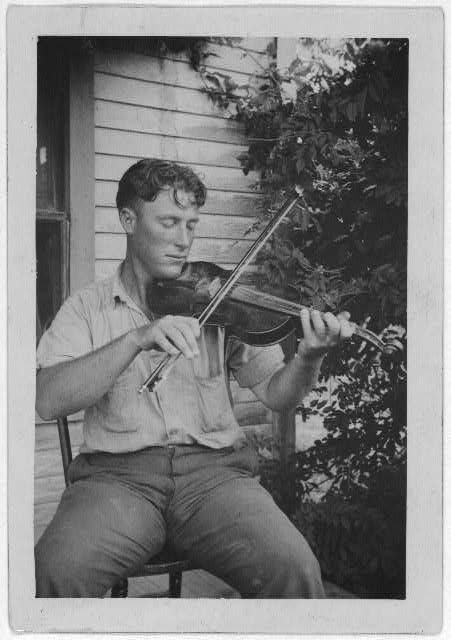
Wayne Perry playing fiddle, Crowley, Louisiana.
Further south in rural, southwest Louisiana, another group of settlers were developing their own musical styles. When the French “Acadians” were forced out of Canada in the mid 1700’s by the British, many settled in the prairies and bayous of Louisiana. These French speaking people had a lot of interaction with Caribbean people who landed in their area through shipping and trading. Through this association, some of the most important elements of “Cajun” music were born.
In the Antilles and San Domingo, a voodoo dance known as “Calinda” was performed in a ritual manner, often involving fighting with sticks. The participants did not always survive unscathed. This dance was brought with the Caribbean people to the Cajun areas, and mixed with the traditional French folks tunes. The name “Colinda” came into widespread use as a somewhat risqué song and dance that the young Cajun French grew quite fond of. The dance was officially banned in 1843 as being “inappropriate,“ but has survived to this day.
Very old, traditional Cajun music is noted for blending African syncopated rhythms with French folk songs, most often played on a pair of fiddles. The result was a highly charged musical style with an emphasis on dancing and singing. In the early part of the 20th. century, the famous Cajun fiddler, Dennis McGee recorded a song named “Madame Young.” This song (with a different title) was taken directly from the original “Colinda” melody. McGee was born in the late 1800’s and grew up listening to and learning traditional Cajun songs from the 18th. And 19th. Centuries. His influence on Cajun music is still heard today.
I suppose the point of these examples is to underscore the importance of our colonial settlers’ contributions to our cultural growth as a nation. Over the past two centuries our country has produced some of the most diverse and influential popular musical styles known. With the cultural merging of so many countries and traditions, our ancestors began the creation of a rich musical legacy that continues to this day. Music has always been an important element in most people’s lives, and I hope the value of these contributions will be appreciated for centuries to come.
As always, your comments, criticisms, and other observations are always welcome.
Thank you,
Jeff Bibb
Guildmaster
December 2013 – Message from the Guildmaster
December 5, 2013 by Jeff Bibb
Filed under Message from the Guildmaster
Hello All:
Monday, December 2nd., the Dow Jones Industrial Average closed down 77 points. Various analysts commented that the market was “disappointed” with Black Friday sales levels and fell off its previous record setting trend. Seems that ever how many millions were spent last Friday just weren’t good enough for our economic growth.
I find this to be a disturbing statement on several levels. Number one, our economy is no longer largely based on what we make and produce. One of the primary economic indicators these days is consumer spending. I am sure that some economists out there will argue this with me into the ground, but that is the major indicator that is always quoted. The days of the United States being the number one producer of goods in the world are over. Want better economic growth?….. spend a lot of money on items imported from other countries, from whom we borrow money. Quite a system isn’t it?
With the Christmas holidays upon us, this message is louder and more clear than ever. Pick up your local Sunday newspaper. It is now so thick with multi-page ads and flyers it is difficult to find the news sections. We joke that if we can recover enough grocery store coupons to pay for the price of the paper, we will be happy.
Twenty or more years ago, Jan and I decided that our days as “typical” Christmas shoppers were over. We asked (ie. pleaded) with family members to join us and make Christmas something more than an exchange of gifts. Some were agreeable with this idea and looked forward to making our holidays more a time of gathering and sharing than running between stores looking for something “special”. Others were appalled that we would dare to fly in the face of the marketing programs designed to empty our wallets and put us in debt for several months. We did it anyway, and have never regretted it.
As members and supporters of the historical community, we have discovered that our area offers a plethora of interesting activities for the Christmas season. All of these can be shared with family and friends and usually involve little or no monetary expenditure. I suspect that many of you have access to similar programs and traditional celebrations this season in every part of our country.
Point of Honor is a mid. 1700’s home inhabited by a long line of Lynchburg, VA citizens. Originally an over 800 acre plantation, it sits on a beautiful hillside above the James River, next to downtown. It’s most notable owner was Dr. George Cabell and his wife, Sarah, during the early 1800’s. Dr. Cabell was a noted physician, a popular local resident, and treated many important people, including Patrick Henry. This past Sunday, Point of Honor held its traditional Christmas open house, offering residents a rare glimpse into the lives and traditions of citizens in the earlier half of the 1800’s. The docents were all properly period attired and the house was decorated with local greenery. Period music was performed in the sitting room. The cook was busy roasting chicken and making bread on the hearth of the large outside kitchen. The large dining room table was set with all manner of delicacies including oysters brought up the James River from Richmond on the bateaux. The 12th. Night cake was the centerpiece of the table. Its recipe includes 40 eggs, 4 lbs. of butter, 4 lbs. of sugar, 5 lbs. of flour and 5 lbs. of fruit. This was a holiday treat looked forward to by all in attendance.
A few miles down the road from Lynchburg near Brookneal is Red Hill, the home of Patrick Henry. Now a fully restored home and farm, Red Hill is a popular destination for colonial history followers. For Christmas the home and farm are opened free of charge to the public. The house is decorated with greenery and docents provide guided tours. Traditional hot cider is offered along with Brunswick stew. Historical boxwood wreaths and “kissing balls” made from mistletoe are available for purchase.
Some miles west in the town of Altavista is the historical Avoca museum. First built in 1755 by Colonel Charles Lynch and named Green Level, the house burned twice during its history, the last time in 1900. The present Victorian Queen Anne style house was constructed in 1901, and stands today, following its complete restoration and full reopening in the 1990’s. At Christmas each year, the grand mansion is opened with period decorations and music along with tours and tasting of traditional holiday treats.
Thomas Jefferson’s homes, Monticello and Poplar Forest, also offer special holiday tours and programs, offering a look at traditional celebrations in centuries past. This is one of the few times that visitors have the opportunity to visit Jefferson’s grand dome on the top level of Monticello. Both programs feature historical attire, decorations and period customs as part of their presentation.
One of the most popular television shows of our time was “The Waltons.” First aired as a Christmas special in 1971, it became a nine year series, detailing the lives of a rural Virginia mountain family during the depression and World War II. Created and narrated by Earl Hamner, the series offered a genuine perspective of a small mountain town and its community. I knew Mr. Hamner as a teenager, and was always impressed by his open, friendly outlook toward life. Growing up and living in a rural mountain area, many of us empathized with the characters portrayed on the show.
The Walton’s Mountain Museum in Schuyler, VA. will be open this weekend for its annual Christmas celebration. Housed in the old Schuyler school building, the museum recreates many of the sets used in the filming of the series. In addition to the furnishings, the museum holds nearly 200 scripts of the series along with lots of memorabilia from the show. Visitors are also allowed access to display areas not normally accessible. While not as grand of a celebration as found at more traditional historical venues, it promises to be a fun glimpse of an important earlier time.
These are just a few of the diverse and entertaining activities that are available to our local populace for the holidays. Friends who accompanied us to Point of Honor this weekend had a great time, and are looking forward to some additional excursions this season. I hope that many of you will spend more time with family and friends during the holiday, perhaps on activities outside the normal Christmas realm. You may disappoint the economic analysts, but I doubt you will disappoint yourself.
May you all have a most joyous and fulfilling holiday season. Good night John Boy…….
Thank you,
Jeff Bibb
Guildmaster
November 2013 – Message From The Guildmaster
November 6, 2013 by Jeff Bibb
Filed under Message from the Guildmaster
Greetings:
In central Virginia, November arrived with the first cold weather of the season. Whether you subscribe to the theories regarding our changing climate or not, it is hard to dispute that our weather patterns are very different from the past. Our ancestors described the colder seasons beginning much earlier than our current times. I suspect that they did not look forward to these months since staying warm required a lot of work in previous centuries.
With the advent of colder weather comes thoughts of the holidays. These days, one barely finishes Halloween before the advertisements begin for Christmas. Thanksgiving has been largely relegated to a day of overindulgence and televised ball sports. In our modern society, the last quarter of the year is one big marketing campaign, designed to spark consumerism, increase personal debt, and bolster the economy.
You have probably head me speak of it before, but as a child our holiday celebrations revolved around the gathering of family and friends. Thanksgiving was a day for our large family to come to my grandparent’s home, usually starting around mid-day, or earlier. The women would be busy in the kitchen preparing the food for the coming meal. They talked and laughed, all the while busily cooking and working under the watchful supervision of my grandmother. Family recipes were held in reverence and one could overhear threads of conversation regarding who made the best rolls, potato salad, lima beans, peach pickle, or chess pie. I think that my mother, aunts, and cousins viewed all of this as a rather pleasant exchange, and looked forward to it each year.
Outside, my grandfather would be planning the day’s traditional “hunt”. This was not a serious quest for game, but a congenial gathering of the family men, in other words, a great excuse to walk over the mountainside carrying guns, smoking or chewing tobacco, and discuss the world as they saw fit. My father, uncles and grandfather could spend hours wandering the hillsides and fields, resolving important questions about what tractor did the best job plowing, or when it would be time to start pruning fruit trees for the coming year. I eagerly followed along, often hoping that attention would turn more toward the serious task of hunting. Usually, thoughts of this nature are known as “wishful thinking”.
Much later, after all of the favorite recipes had been exchanged, and all of the rabbits, squirrels and quail were safely tucked into their burrows and nests, we would sit down to dinner. In central Virginia, one does not refer to dinner as just an evening meal. Dinner is often an expansive (and time-consuming) mid-day or afternoon meal. This custom extends back for centuries and is common in many parts of the South. One easy way to seriously offend my paternal grandmother was to thank her for “lunch”. This would generate a sour look and a loud exhalation of disgust, along with an admonition that “lunch” was not what we had just enjoyed.
In our home, Thanksgiving dinner was served at several tables. The main table in the dining room was reserved for the primary (and older) family members. My grandfather would be at the head of the table, my father and mother immediately to his right. My paternal grandparents would be seated there, along with my closest aunts and uncles. Other family members and friends would be seated at another table in the living room. The children had their own table, usually in the den. We thought this was great fun, since we were free to talk as we liked, and return to the serving table for “seconds” as we wished.
Dinners of this type sometimes lasted for hours. It seemed there was an inexhaustible supply of topics for conversation. There also appeared to be an unending supply of food. My grandmother rarely sat down to eat until later. She was busy bringing in a large array of side dishes and several servings of rolls, fresh out of the oven. Everyone was advised to “butter a hot one” so as not to be left without a suitable piece of bread during the meal. Of course we all complied with her wishes, not wanting to offend a woman who was admired for her baking abilities.
Later hours would find everyone seated in the living room, enjoying more lively conversations and discussing the local community and its inhabitants. There were many colorful characters in our area, and stories often surrounded their lives and exploits. In the evening, as folks began to leave, they made plans for Christmas, deciding which nights would be filled with more food and celebrations. My family enjoyed these times immensely. They would talk for weeks about the holidays, and everyone present.
I suppose the message of these holidays was simply the opportunity to be together and share as family and friends without commercial distractions. I hope that some of you still enjoy these occasions, and the opportunity to gather with those you love. These days, almost all of our family is gone, and there will be no more holidays like the ones from my youth. I miss those times, and often think of them. We visit with close friends for the holidays, but nothing like times past.
May all of your holiday seasons be enjoyable and rewarding.
All the best,
Jeff Bibb
Guildmaster
October 2013 – Message from the Guildmaster
October 8, 2013 by Jeff Bibb
Filed under Message from the Guildmaster
Hello:
Fall has officially arrived in central Virginia, although it is hard to tell since the temperatures remain in the 80’s, the trees have not turned, and only a few scattered leaves are falling. Usually we have had some chilly nights, and a hint of the cold to come. Some years have provided a light snow prior to Halloween. This year we are still mowing the yard. I have been watching the weather forecast for Charleston, SC in anticipation of our annual trip there. Looks pretty much like here, with 80’s during the day and a bit milder nights than we have. Maybe we should save some money and just stay home.
I don’t know about your part of the country, but the weather and our natural world have been very strange this year. Of course we have witnessed a succession of warmer seasons over the past few years with little or no snow in the winter, and many mild days in the coldest months. Our summer began with unending rain. It appeared we would have a wet and very green season…. until July when it all stopped and adequate rainfall has been in very short supply. Stream levels are falling quickly, and the ground is extremely dry.
Jan is a prolific gardener, and we joke about our “tomato jungle” each year. Most years we are harvesting tomatoes well into October before the plants finally give out. Even with constant watering, this year everything was pretty much gone by September. The hardy pepper plants lasted a while longer, but not like most seasons.
In our back yard are three large, old chestnut trees. By September we are normally roasting nuts on a daily basis, and trading them with our friends. This year there are no chestnuts to be found. We have counted perhaps a dozen burrs on the ground, and earlier saw none on the trees. The few that fell were quickly scooped up by the deer. It was also surprising to see squirrels carrying green chestnut burrs in their mouths, hoping to recover the nuts inside.
Our giant old oak trees have no acorns at all. The abundant crop of walnuts that cover parts of our yard are nowhere to be found. Hickory nuts are non-existent. It is not just us, as I have discovered. All of our friends indicate the same at their houses. No nuts of any kind on any trees. Some folks have speculated that the cicadas were responsible since they lay their eggs at the end of branches, which then turn brown and die in a month or so. All over our mountain are trees with dead branch ends. I am not a scientist, but I find this theory hard to swallow since chestnuts in particular are usually present all along the tree branches.
In addition to this lack of natural food, the squirrel population has skyrocketed. Walking out of our back door, it is not difficult to see a dozen or more in the yard and the trees. Dead squirrels are everywhere on the road. It is sometimes hard to miss them when ten or more dart in front of the car while driving around the mountain. The deer population remains strong, and there are an abundance of wild turkeys.
Along with these animals, there seem to be more bears than ever. Our friends across mountain have had a real problem with bears coming after their guineas and getting into their trash. Yesterday, one of our neighbors reported two bear cubs in her yard, playing along her rock wall. A bear was seen in the city of Lynchburg last week, and there have been have more numerous sightings than usual.
There has also been a real problem with yellow jacket nests this year. Most years we find one, or maybe two somewhere in the yard. This year we have seen ten or more, and unfortunately have encountered them in their worst mood. Mowing over a yellow jacket nest is not the most pleasant way to spend an afternoon. A number of these in-ground nests have also been raided by various animals. I understand that bears, foxes, and skunks will root out the nests and eat the bees. Parts of our yard look like a geological project with large holes dug around the bee nests.
It seems that the animals are looking for food and none is to be found. I am curious how they will fair over the winter as a result? Will we witness a decline in the animal populations over the next few years? If the natural food situation does not change, I think it will be unavoidable, and the consequences will have a real impact on our natural world.
Regardless of your position and beliefs concerning global warming, it is difficult to deny that our world has, and is, changing. As a farmer, my grandfather kept extensive diaries through the first half of the 1900’s. He noted each day’s weather in relation to the work and productivity of his farm and crops. Looking back at them, it is startling to see how much colder and wetter this area was than during the past forty or so years. It was not uncommon for snow to begin in November or December and last throughout the winter. He writes about many days of pruning fruit trees in the snow, or getting up to feed cows and chickens in the cold weather.
As I mentioned earlier, I am not a scientist, and I do not have answers for the environmental changes we are witnessing. Thomas Jefferson saw the future of our country as a largely agrarian society, maintaining its beautiful, natural landscape. I believe he would be very disappointed with the directions we have taken.
As always, I invite your comments, criticisms or other observations. Until next month, I hope that you enjoy the fall season.
All the best,
Jeff Bibb
Guildmaster
September 2013 – Message from the Guildmaster
September 9, 2013 by Jeff Bibb
Filed under Message from the Guildmaster
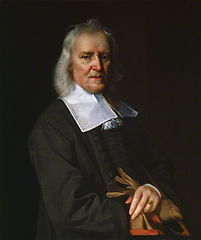
Izaak Walton, 17th century author of “The Compleat Angler”
Hello:
With the coming of September, fall is beginning to make its presence. A few leaves are changing colors, and nights are definitely a bit cooler. The sun is a little later coming up each morning, promising to lose some of its intense heat from prior months. We look forward to the changing colors, and hopefully a decline of yellow jacket nests buried in our yard.
We are fortunate to have a beautiful Izaak Walton park not far from our house. This park was established many years ago and grew to its present 325+ acres through the years. It features two lakes, one reserved for swimming and paddling, another devoted to fishing. The central clubhouse is bordered by a large picnic area, campground, kids playground and wading pool, skeet, trap, and sporting clays ranges, a beautiful wooded 28 station walking archery course, a 300 yard rifle and pistol range, hiking trails, and much more. We enjoy going there, and supporting the national organization which focuses on conservation and preservation of our natural resources. With annual family dues under $200.00, this park is one of the best values in our local area.
A couple of weeks ago the park held its annual open house. This day-long event is held each year late in August to promote membership and make the public more aware of the benefits available to them as members. This Saturday proved to be a perfect choice with sunny skies and moderate temperatures in the lower eighties. One member brought a half dozen kayaks and canoes for all to try out on the lake. There were food vendors, free rounds at the shotgun sports and shooting ranges, raffles for a new canoe and other prizes, tours of the facilities, and special incentives for new members. The national organization was present to talk about Izaak Walton and educate folks about its programs and goals.
Jan and I invited two of our best friends who had two young grand nieces visiting their farm for a couple of weeks. My older cousin’s grandsons were staying with them for the weekend, and we offered to take them along as well. We packed picnic lunches, swimming suits and sunscreen, shotguns and bows, and off we went.
Needless to say, the park was busy that day. All the kids (and adults) swam and paddled in the lake. By three o’clock in the afternoon, we had to pry them out of the water to go home. Seemingly tireless, they were enthralled with paddling kayaks and diving off the board into the clear lake. Our friends enjoyed the lake as well as the archery course, and we had a large turnout of folks at the shotgun ranges. At the end of the day, the park had gained over thirty new members.
I was at the park the next day to shoot some skeet and trap. Gazing down the drive toward the lake, I was not surprised to find it deserted. The picnic grounds were empty as well, and only a few cars passed during the afternoon as a couple of campers returned to their sites, and other folks ventured down to the shooting ranges. Life at Izaak Walton Park had returned to its normal state, one that is sad and frightening at the same time.
Talking with other older members reaffirmed my initial impressions. We reminisced about earlier days in the 1960’s and 70’s when the park would be filled each weekend, buzzing with activity. During the summer months, the lake and beach would be crowded every weekend with folks driving out from Lynchburg and other areas to enjoy the park. There was a busy concession stand at the lake, selling snacks, ice cream, and drinks. The clubhouse was often rented for weddings, family gatherings, and other events. Membership was much higher than it currently stands. The park was a popular place for many people.
Even though the park has managed to maintain a good membership level, and several of its facilities are well-used, I wonder what happened to the other areas. I suppose with the advent of urban swim clubs, there is less interest in spending the day outside at a beautiful lake, listening to kids splash and play, and cooking out on the grills at the picnic grounds. Folks just don’t have time any more, nor do they seem interested in preserving and enjoying the natural resources around them. I suppose it is much easier to drive to the pool in town and stop at a fast food place on the way home, all the while talking and texting on their mobile devices, ignoring the world around them.
The kids we brought to the park had an incredible time. They were outside all day, enjoying themselves, but learning as well. Only one of them had ever paddled a kayak before. When we went to the archery range, they each had turns shooting the bow. They had new experiences, met new people, enjoyed their picnic lunch, and never mentioned cell phones, fast food or video games. I encourage you to spend some time with folks, young or old, outside in the natural world. A small amount of encouragement may be all that is needed to help some people gain a better understanding and appreciation of the world around them, beyond the artificial confines of their homes, cars and electronics.
The Izaak Walton Member’s Pledge:
“To strive for the purity of water, the clarity of air, and the wise stewardship of the land and its resources; to know the beauty and understanding of nature, and the value of wildlife, woodlands and open spaces; to the preservation of this heritage and to man’s sharing in it. I pledge myself as a member of the Izaak Walton League of America.”
In my mind, these are certainly important values for us all. Until next month, your thoughts, opinions and feedback are always welcome.
All the best,
Jeff Bibb
Guildmaster
Special Announcement – Muzzle Blasts Features “Guildmaster-End of Day”
August 26, 2013 by Jeff Bibb
Filed under Message from the Guildmaster
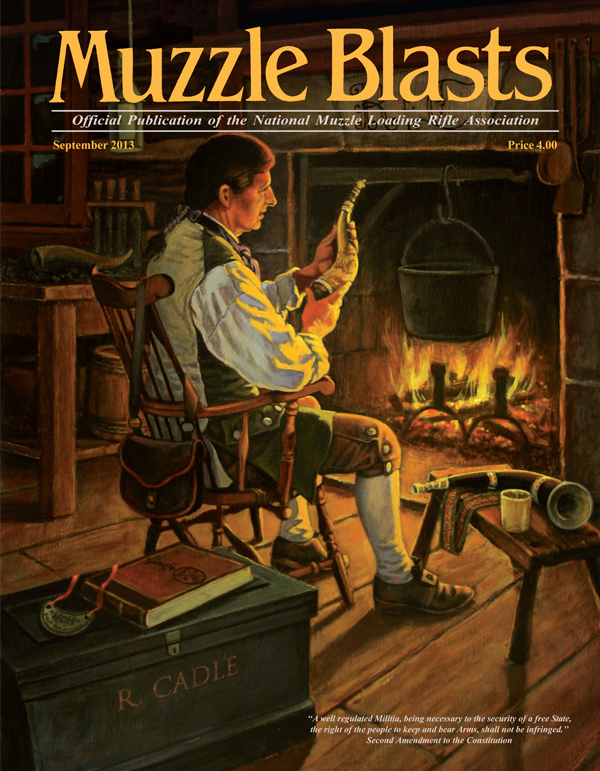
Dear Members,
The Honourable Company of Horners has had a longstanding, positive relationship with the National Muzzle Loading Rifle Association; one would be hard-pressed to find an issue of the NMLRA’s membership magazine that does not reflect the closeness of our two organizations.
We are excited to see that Bob Albrecht’s “Guilmaster-End of Day” not only made the cover, but the story behind the painting of Roland Cadle, master horner and founder of the HCH, is featured in the September issue of Muzzle Blasts.
To find out more about the NMLRA, check out their website here.
Bob Albrecht, journeyman horner and fine artist, has a website and can be found here.
All the best,
Jeff Bibb, Guildmaster
August 2013 – Message from the Guildmaster
August 8, 2013 by Jeff Bibb
Filed under Message from the Guildmaster
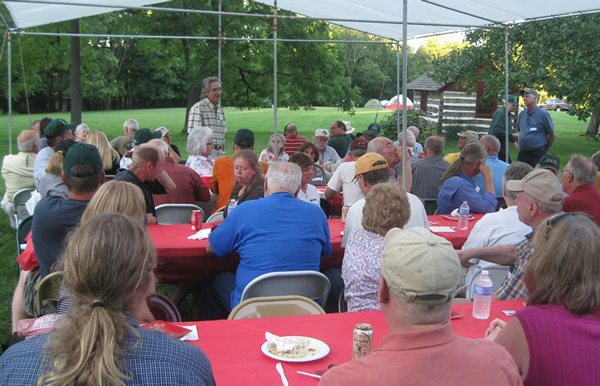
Jeff Bibb welcomes all to the 2013 Summer Reception at Jacobsburg Historic Site.
Hello,
On the drive home from Dixon’s Gun Maker’s Fair last Sunday night, I had a lot of time to think and review the events of the weekend. Dixon’s is always a special time for many of us. This year was no exception. Our HCH table was well-staffed, and a special Thank You goes out to all who helped this year. Sales for raffle tickets, Horn Books, and our new Dixon’s Accoutrements Pamphlet were brisk, and I received many compliments about our organization. Dick and Regina Toone showed up with our “fully-functional” spring pole lathe, and drew a crowd all weekend. Several guild members were also set up in the tent, and we all had a grand time. Friday night’s dinner at Jacobsburg was well-attended, and the weather was beautiful.
The accoutrements competition is a big event. and several of our members were involved for most of the weekend. Many of us have entered over the years, and guild members make up a portion of the judging staff. We were once again treated to a wide range of entries with horns, bags, knives, powder measures, hawks, and items of every possible description. If it was period gun-related, it was there for us to see. I hope you took time to come by and view the outstanding array of entries presented on the tables. Also, I would like to extend a special congratulations to the guild members who won ribbons and special awards in this year’s competition.
I will note that the overall number of entries has fallen off over the past couple of years. Whether this is due to natural attrition of the artisan base, the economy and cost of travel, or if there are less folks interested in making items to enter, it is disappointing when entries decline. On the other hand, the number of first-time entries was much higher, and almost one third of the items entered were in this category. I cannot speak for the gun judging, but looking at their tables, I did not see the quantity of guns usually displayed.
All of this, and more, occupied my thoughts as I motored down Interstate 81 toward home. Art is a creative process. Certainly the work that our artisans produce greatly relies on this ability. It is the same in any artistic endeavor…. painting, gun-making, sculpture, powder horns, metal work, mixed media, knives, music, landscaping, hunting bags, weaving, quill work, and so on. Last month I wrote about a particular friend who was a prime example of this creative force. Whether making a new gun or crafting a piece of furniture or jewelry, he embodied a sense of creativity that never dulled. He loved to learn new skills, and would tackle any project.
Our ancestors were certainly creative folks. In one sense they had to be with the demands of their difficult daily lives. In those times, one could not drive over to the store and procure whatever was needed, or order it on-line. Money was also a concern since the standard of living in colonial and early American times was not particularly high. Being a largely agrarian society, folks stayed at home and made what they needed, or traded for it if they could not produce it themselves.
All of this contributed to a populace who saw a problem or need, and then proceeded to fashion it themselves. Guns were of course mostly made by “professional” gun makers, and a large group of uniquely American gun makers appeared and thrived following the revolution. Today these individuals are revered for their amazing ability to build fine rifles, fowlers and pistols with nothing more than basic hand tools. They were some of the true artisans of their time.
At home, people crafted their own clothing, tools, furniture, knives, utensils, horns, bags, and grew most of their own food. Many of these items have survived to be as respected as their firearm counterparts. Up through most of the 20th. Century, a sewing machine was a standard fixture in most homes. Making one’s own clothes was a valuable (and money-saving) skill. The Singer Sewing Machine Company produced many thousands of machines from the later 1800’s onward. A lot of these 100+ year old treadle machines are still in operation and capable of producing beautiful work. Our friend, Suzanne, collects and regularly uses these early treadle machines. Often found in near perfect, original condition for less than $100.00, they are ready to run for another 100 years.
So it is with other “tools of the trade” in our modern times. Useful and well-made tools can often be purchased for little cost at yard sales, auctions, and other shops. Many of these are in excellent condition and ready to use for many years. I suspect the main reason they are so readily available is that few people have an interest in using them any longer. Skills that were once respected and admired have been relegated to a position where they are largely ignored by much of our population. In our complicated modern lives, no one is interested in taking the time to learn to make something when it can be easily purchased. With this comes the loss of personal satisfaction and feeling of accomplishment when one makes something of their own.
The need to create in our own lives has been supplanted by technology and consumerism. Much of this has occurred over the past 50 – 60 years following World War II, and risen sharply in the last several decades. The danger in all of this is obvious. When our population loses its ability to support itself, what will the outcome be if the need arises? Much has been written on this subject by far more intelligent individuals than myself, but I cannot help wondering how these millions of folks will take care of themselves if they have to? I suspect the answer is painfully obvious. From my own prospective, an important part of our “freedom” is the ability to think first, and then act as needed to make our way. Without practicing these skills, we are simply sheep who can be herded as needed by their handlers.
I hope that this loss of creativity and individual skills will change in coming years. From the direction of our society I do not see much hope, but it is a goal that we, as artisans and thinkers, can perhaps help sway in some small way. As always, I welcome your thoughts, observations, and criticisms.
All of the best,
Jeff Bibb
Guildmaster





